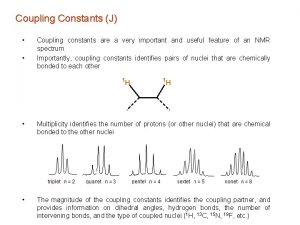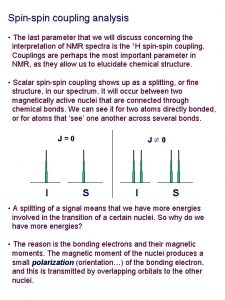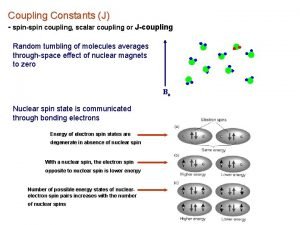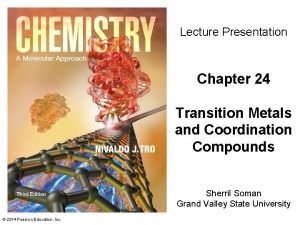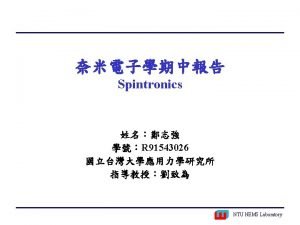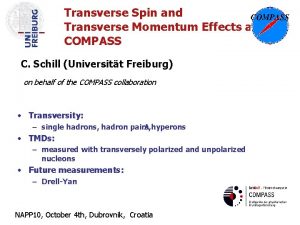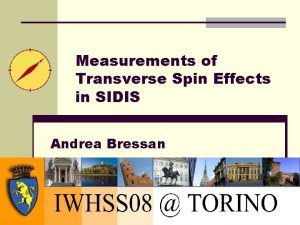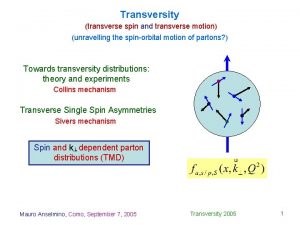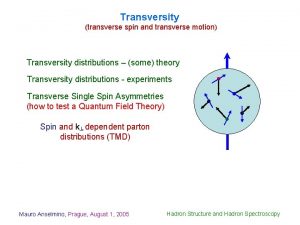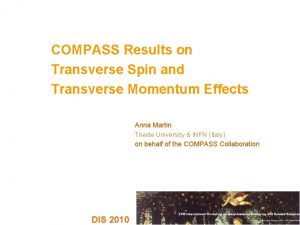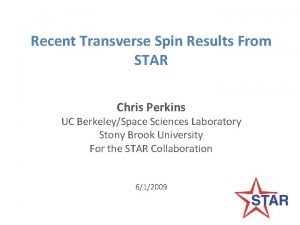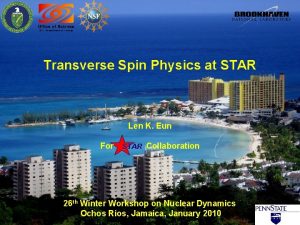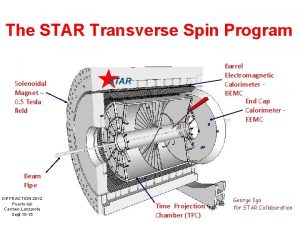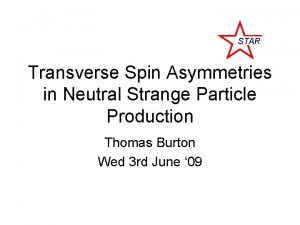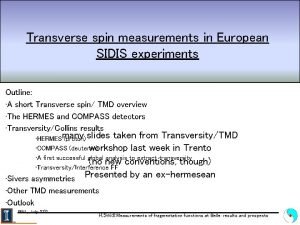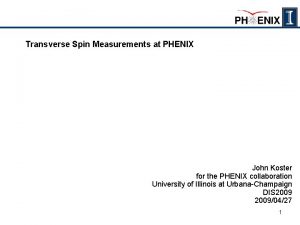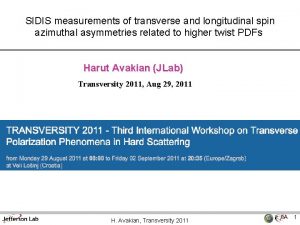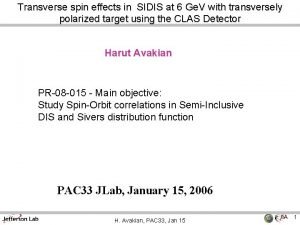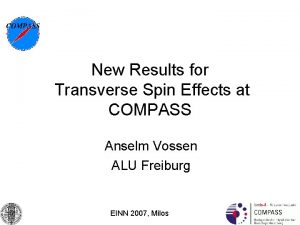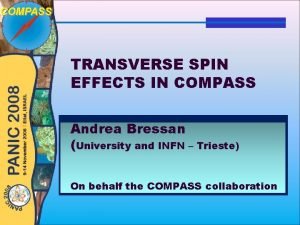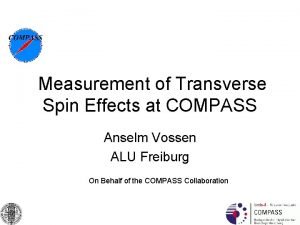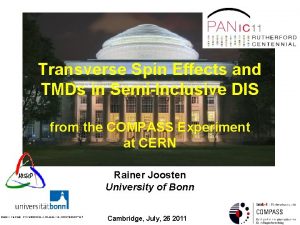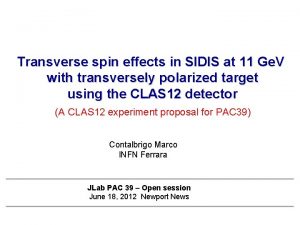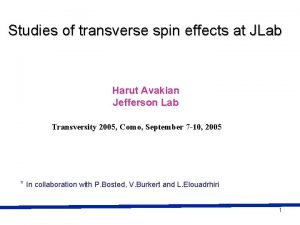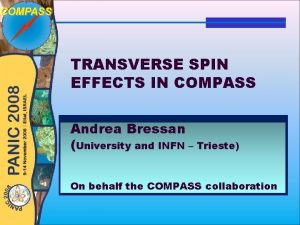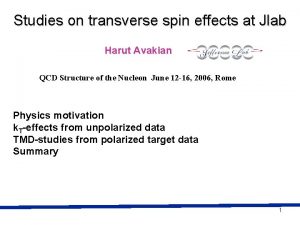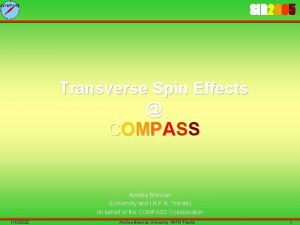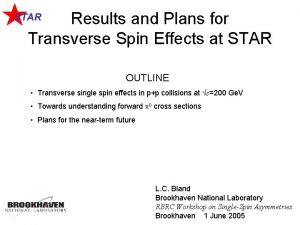STAR Measurements of transverse spin effects in the



















![Possible mechanisms • Sivers effect [Phys. Rev. D 41, 83 (1990); 43, 261 (1991)]: Possible mechanisms • Sivers effect [Phys. Rev. D 41, 83 (1990); 43, 261 (1991)]:](https://slidetodoc.com/presentation_image_h/330a69d6f1cdbd92ea7de0e168e5699f/image-20.jpg)




- Slides: 24

STAR Measurements of transverse spin effects in the forward region with STAR detector L. Nogach, IHEP, Protvino for the STAR Collaboration Outline: • Motivation • STAR detector • Inclusive 0 measurements • More possibilities with the FMS • 2009 run at √s=500 Ge. V • Summary and outlook DSPIN-2009, September 1 -5 1

Motivation • Contrary to simple p. QCD predictions, first measurements f of production in p↑p collisions found large transverse single spin asymmetries. Similar large effects have recently been found in e+e- and semi-inclusive deepinelastic scattering. • Significant developments in theory in the past few years suggest common origins for these effects, but large transverse spin asymmetries in p↑+p → + X production are not yet fully understood. • More fundamental question: what is the underlying dynamics in kinematics where transverse spin effects are observed? 2

Polarized pp collisions at RHIC p. C Polarimeters Absolute Polarimeter (H jet) Siberian Snakes PHENIX STAR Spin Rotators (longitudinal polarization) Pol. H Source LINAC Spin Rotators BOOSTER 200 Me. V Polarimeter AGS Strong AGS Snake pp run Year <Polarization>, % Lint [pb-1] at STAR (T) Helical Partial Siberian Snake AGS p. C Polarimeter FOM=P 2 L 2002 2003 2005 2006 2008 15 30 45 55 50 0. 15 0. 25 0. 1 6. 8 ~7. 8 3

STAR detector layout FMS TPC FPD BBC BEMC FPD FMS Modular detector • • 20 x acceptance of previous forward detectors at • STAR Small x. F-p. T range compared to FMS • Full azimuthal coverage for 2. 5 < η < 4. 0 • Array of 1264 Pb-glass cells FPD FMS 4

Published measurements with the FPD (2002 2006) PRL 92, 171801 (2004) PRL 101, 222001 (2008) • AN at positive x. F grows with increasing x. F • x. F dependence matches theoretical model expectations qualitatively • p. T dependence at fixed x. F is not consistent with 1/p. T expectation of theoretical model calculations √s=200 Ge. V, <η> = 3. 8 U. D’Alesio, F. Murgia Phys. Rev. D 70, 074009 (2004) ar. Xiv: 0712. 4240 C. Kouvaris, revealed J. Qiu, W. Vogelsang, F. Yuan, Asymmetry at lower energies Phys. Rev. D 74, 114013 persists at √s=200 Ge. V(2006) 5

Inclusive h AN measurements (2006) Asymmetry for h-mesons is larger than for 0 (similar to the E 704 measurements): (AN)h = 0. 361 ± 0. 064 for 0. 55<x. F<0. 75 ar. Xiv: 0905. 2840 6

Inclusive 0 AN with the FMS (2008) Octant subdivision of FMS for inclusive 0 spin sorting ar. Xiv: 0901. 2828 y x P • Azimuthal dependence appears to be as expected • AN is comparable to prior measurements with the FPD 7

AN(p. T) at |x. F|>0. 4 with the East FPD/FMS (2008) negative x. F positive x. F • AN for negative x. F consistent with zero • Indication of AN for positive x. F persists up to p. T ~5 Ge. V/c • Needs more transverse spin running ar. Xiv: 0901. 2763 + A. Ogawa @CIPANP 09 8

High x. F vector mesons 3 photon events to look for w 0 g (BR= 8. 9%) • p. T(triplet)>2. 5 Ge. V/c • E(triplet)>30 Ge. V • p. T(photon cluster)>1. 5 Ge. V/c • p. T( 0)>1 Ge. V/c Background only MC Run 8 FMS data Fit is Gaussian + p 3 μ=0. 784± 0. 008 Ge. V σ=0. 087± 0. 009 Ge. V Scale=1339± 135 Events Significant (10 s) w 0 g signal seen in the data => possibility to measure spin-1 meson AN ar. Xiv: 0906. 2332 9

First look at “jet-like” events in the FMS “Jet-shape” distribution of energy within jet-like objects in the FMS as a function of distance from the jet axis Event selection: • • • “Jet shape” in data matches simulation well • Reconstructed mass does not match as well • High-tower trigger used in Run 8 biases jets >15 cells with energy > 0. 4 Ge. V in the event (no single pions in the event) cone radius = 0. 5 (η-φ space) “Jet-like” p. T > 1 Ge. V/c, x. F > 0. 2 2 perimeter fiducial volume cut (small/large cells) ar. Xiv: 0901. 2828 10

Forward 0 - 0 azimuthal correlations • Possible back-to-back di-jet/di-hadron Sivers measurement • Possible near-side hadron correlation for Collins fragmentation function/ Interference fragmentation function + Transversity • Low-x / gluon saturation study – accessing lowest x. Bjgluon 11

Benchmark for Drell-Yan: First look at J/ψ → e+ + e- in the FMS Reconstructed 2 -cluster invariant mass Fit with Gaussian + Offset Gaussian fit parameters: – μ = 3. 080 ± 0. 020 Ge. V/c 2 2 High-x – σ = 0. 082 ± 0. 026 Ge. V/c F, high mass dilepton – χ2/d. o. f. = 20. 83/26 pairs are – Significance from the fit difficult to reconstruct 4. 5 σ Cuts applied: – – ar. Xiv: 0907. 4396 E_pair > 60. 0 Ge. V zγγ < 0. 7 Isolation radius: 0. 4 η-φ p. T_cluster > 1. 0 Ge. V/c First high-x. F J/ψ measurement at √s > 62 Ge. V 12

2009 – first physics run at √s=500 Ge. V Luminosity: 56 x 56 bunches with 1. 8 x 1011 intensity; 10 pb-1 integrated Polarization: ~30% (longitudinal) Forward Pion Detector module schematic: Shower Maximum Detector lead converter 7 x 7 matrix of lead glass cells preshower (7 Pb-glass cells) First look at o event reconstruction in the FPD: • using matrix+preshower (no SMD data) • 20 Ge. V < Etotal < 80 Ge. V • fixed vertex (z=0), no minbias condition • Ng=2 fit by Gaussian+”gamma” function 13

2009 data at √s=500 Ge. V FPD measures energy up to ~200 Ge. V ═> SMD information is required to reconstruct pions above ~60 Ge. V Example of 2 -photon event when two clusters significantly overlap in the matrix, but are clearly separated in the SMD 14

Forward Hadron Calorimeter • Proposed to be staged at a minimal Dz from the FMS symmetrically of DX magnet • two matrices of 9 x 12 Pb-scintillator detectors • real jets physics with FMS+FHC • polarization transfer coefficients through measurement of polarization in the n 0 channel first simulations of →n 0 15

Summary • Large transverse single spin asymmetries at large h are observed up to √s=200 Ge. V. • High precision inclusive 0 AN measurements with the FPD allow for a quantitative comparison with theoretical models. • FMS allows to look at heavier mesons, “jet-like” events and particle correlations. • Essential to go beyond inclusive production to disentangle dynamical origins. 16

Outlook • Measurements of AN in inclusive 0 production at √s=500 Ge. V (Run 11? ). • Extend forward calorimetry to have hadronic capability (FHC) to measure full jets and to study inclusive production. • Extend measurements of transverse single spin asymmetries from hadron production to prompt photon and jets. • Develop RHIC experiment for a future measurement of transverse single spin asymmetries for Drell-Yan production of dilepton pairs. 17

Backups 18

Single Spin Asymmetry • Two methods of measurements: • Single arm calorimeter: Definition: dσ↑(↓) – differential cross section of 0 when incoming proton has spin R – relative luminosity (by BBC) Pbeam – beam polarization up(down) Left 0, x. F<0 , x. F>0 • Two arm (left-right) calorimeter: p p Right positive AN: more 0 going left to polarized beam No relative luminosity needed 19
![Possible mechanisms Sivers effect Phys Rev D 41 83 1990 43 261 1991 Possible mechanisms • Sivers effect [Phys. Rev. D 41, 83 (1990); 43, 261 (1991)]:](https://slidetodoc.com/presentation_image_h/330a69d6f1cdbd92ea7de0e168e5699f/image-20.jpg)
Possible mechanisms • Sivers effect [Phys. Rev. D 41, 83 (1990); 43, 261 (1991)]: Flavor dependent correlation between the proton spin (Sp), proton momentum (Pp) and transverse momentum (k. T) of the unpolarized partons inside. The unpolarized parton distribution function fq(x, k. T) is modified to: • Collins effect [Nucl. Phys. B 396, 161 (1993)]: Correlation between the quark spin (sq), quark momentum (pq) and transverse momentum (k. T) of the pion. The fragmentation function of transversely polarized quark q takes the form: According to the latest theoretical developments, both mechanisms 20 contribute to AN

Separating Sivers and Collins effects Sivers mechanism: asymmetry in the forward jet or g production SP Collins mechanism: asymmetry in the forward jet fragmentation SP k. T, q p p p Sensitive to proton spin – parton transverse motion correlations p Sensitive to transversity Sq To discriminate between the two effects we need to go beyond 0 detection to direct photons or jet-like events k. T, π 21

0 inclusive cross section Cross-section is consistent with NLO p. QCD calculations PRL 97, 152302 (2006) nucl-ex/0602011 22

Forward 0 – midrapidity azimuthal correlations p. QCD inspired “GSV cuts” (Guzey, Strikman and Vogelsang, hep-ph/0407201): • |ηTPC| < 0. 9 ; 2. 8 < ηFMS < 3. 8 • 2. 5(2. 0)Ge. V < p. TFMS • 1. 5(1. 0)Ge. V < p. TTPC < p. TFMS • |zγγFMS|< 0. 7, 0. 07 < Mγγ < 0. 30 Ge. V • only leading particle considered, corrected for pile-up • as proposed in hep-ex/0502040 • Possible back-to-back di-jet/ di-hadron Sivers measurements • Low-x / gluon saturation study • Step-stone towards transverse spin forward photon-jet ar. Xiv: 0907. 3473 23

Future runs at RHIC Year FY 10 Likely Beam Species Science Goal Au+Au at 200, 62. 4 Ge. V, low-mass dilepton spectrum; early collision temp. ; improved jet quenching studies; begin assorted lower energy scan for critical point FY 11 Subinjection Au+Au; 500 Ge. V p+p; short 200 Ge. V U+U continue critical pt. search; gluon pol’n at low x + antiquark pol’n from W production; 1 st characterization of deformation effects in U+U centrality distributions FY 12 Au+Au at 200 Ge. V; 500 Ge. V p+p RHIC-II heavy ion goals: heavy flavor, g-jet, quarkonium, multi-particle correlations; antiquark polarization in proton FY 13 200 Ge. V p+p; further heavy ion running to complement earlier runs continue RHIC-II heavy ion goals; transverse spin asymmetries for g+jet; pp reference data for new subsystems FY 14 200 Ge. V Au+Au; low-E Au+Au dictated by Run 10+11 results continue pursuit of g+jet; energy scal and identified heavy flavor 24
 Myrrh is mine its bitter perfume
Myrrh is mine its bitter perfume Geminal coupling
Geminal coupling Spin spin coupling
Spin spin coupling Spin spin coupling
Spin spin coupling What is a low spin complex
What is a low spin complex Spin up spin down
Spin up spin down Peritoneal cover
Peritoneal cover A* and ao* algorithm
A* and ao* algorithm What do star events stand for
What do star events stand for Tư thế ngồi viết
Tư thế ngồi viết Bàn tay mà dây bẩn
Bàn tay mà dây bẩn Hình ảnh bộ gõ cơ thể búng tay
Hình ảnh bộ gõ cơ thể búng tay đặc điểm cơ thể của người tối cổ
đặc điểm cơ thể của người tối cổ Mật thư tọa độ 5x5
Mật thư tọa độ 5x5 Tư thế ngồi viết
Tư thế ngồi viết ưu thế lai là gì
ưu thế lai là gì Voi kéo gỗ như thế nào
Voi kéo gỗ như thế nào Thẻ vin
Thẻ vin Thơ thất ngôn tứ tuyệt đường luật
Thơ thất ngôn tứ tuyệt đường luật Các châu lục và đại dương trên thế giới
Các châu lục và đại dương trên thế giới Từ ngữ thể hiện lòng nhân hậu
Từ ngữ thể hiện lòng nhân hậu Diễn thế sinh thái là
Diễn thế sinh thái là V. c c
V. c c Vẽ hình chiếu vuông góc của vật thể sau
Vẽ hình chiếu vuông góc của vật thể sau Frameset trong html5
Frameset trong html5

